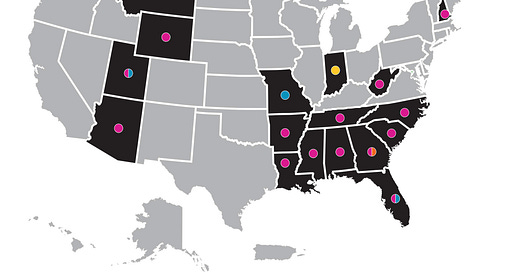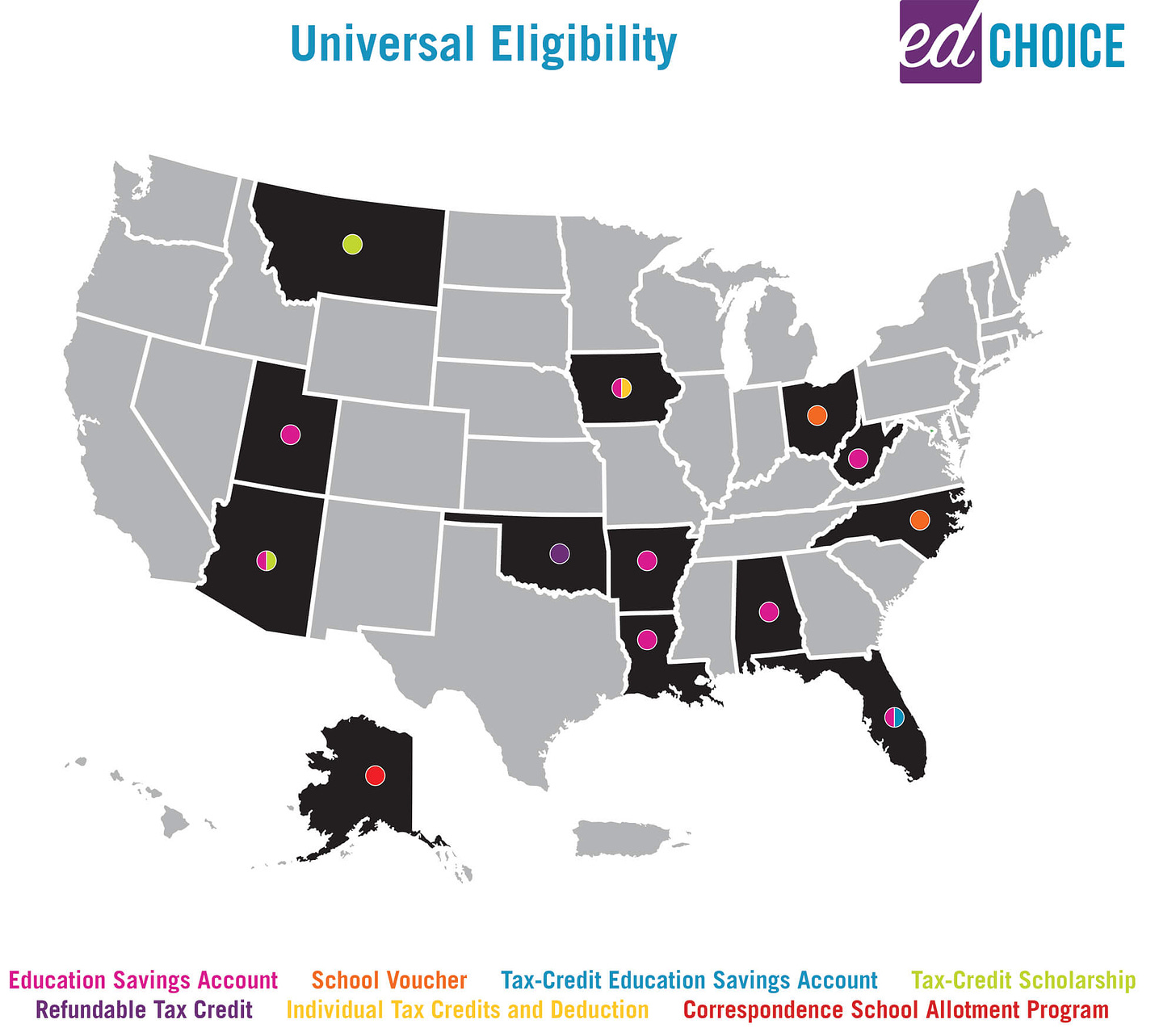What Universal School Choice means and what to expect in 2025
A conversation with Ed Tarnowski from EdChoice about the huge wave of school choice sweeping the country (but not NY yet)
I recently met
from EdChoice and learned about the three types of universal school choice. This is not the reality in NY yet but it is growing across the country. Here is our conversation:2024 was a big year for school choice. How many states now have full school choice? How many have some level of education freedom?
In 2024, five states (AL, GA, LA, NE, and WY) created new choice programs and six (IN, MO, NC, OK, SD, and UT) expanded existing programs like education savings accounts (ESAs), vouchers, refundable tax-credits, and tax-credit scholarships. Unfortunately, Nebraska’s new program is being dissolved as a result of a state ballot measure. This brings the number of states using choice programs to 33 states + Washington, DC and Puerto Rico. Four of those states have fully universal programs.
Do you think 2025 will be even better? Which states are you watching as they could pass school choice legislation next year?
There are many exciting prospects for education freedom policy going into 2025. In last month’s election, candidates supporting educational choice enjoyed wide electoral success in states across the country. The states we are watching most closely for enacting expansive choice include Idaho, New Hampshire, Tennessee, and Texas. We also have our eyes on Missouri, Montana, North Dakota, and South Carolina.
You taught me about the 3 types of universal school choice. Can you explain to NY families what they are and how they impact families?
Absolutely! This year, EdChoice defined the three pillars of universal educational choice: Universal eligibility, usage, and funding. With so many using and interested in using choice, it is more important than ever to design programs with families at the center.
With eight states enacting programs open to all families in 2023, it is hard to deny that it was the year of universal eligibility. This was a monumental year for the education freedom movement led by parents. Still, universal eligibility standing on its own poses challenges to be overcome. It is the beginning of true universal choice, not the end.
For example, when Utah passed its program with universal eligibility in 2023, all K-12 students in the Beehive State became eligible to participate. But not all could actually participate. With $40 million appropriated for scholarships, as soon as enough students apply to meet the $40 million funding cap, new applicants are placed on a waitlist and no more students may be admitted until more money is appropriated or the number of participating students drops.
Luckily, this year, Utah doubled its appropriation for scholarships from $40 to $80 million, doubling the number of students who may participate from about 5,000 to 10,000. This is excellent news for families, but doesn’t solve the underlying problem, especially with increasing demand for choice. As soon as enough students apply to meet the new cap, new applicants will be waitlisted and dependent on the legislature to appropriate more money. To ensure all are guaranteed access to choice, states facing this conundrum can instead tie the program’s funding to the state’s education funding formula. This way, families are not at the mercy of government passing new laws to increase funding. Instead, tying the program to the funding formula scraps funding caps and ensures a percentage of the average per-student state education funding follows the participating student regardless of how many apply.
While Utah has not yet met the criteria for universal funding, it is meeting the moment for universal usage. ESAs changed the game for the choice movement, taking it a step further than traditional vouchers. Rather than a voucher being allocated to a participating family to attend a private school, ESAs empower families with a publicly-funded, government-authorized savings account to use on a wider list of qualifying expenses, allowing them to customize their children’s education. Some of the most common qualifying expenses include tuition, tutoring, curriculum, educational therapies, textbooks, instructional materials, transportation, online education, etc. Utah meets the criteria for universal usage by offering a wide range of qualifying expenses. However, not all ESAs are created equal. Some are more restrictive.
For example, Iowa passed an ESA program with universal eligibility and funding that is already going a long way to strengthen Hawkeye families. Still, being a tuition-first model, it has room to empower families with a truly customized education by widening how they may use funds.
When building a choice program, it is crucial to get the details right to ensure all families who want it can access choice in their education. It can mean the difference between countless kids attending a school that meets their needs or not. Further, to unleash the power of opportunity, market forces, and the entrepreneurship of educators, states can work to enact a money-follow-the-child education funding system.
Below, I will break down the three pillars of universal educational choice that can move us in that direction.
Pillar #1, Universal Eligibility: Every student in the state must qualify for the program. While in the past programs were limited to low-income students or students with special needs or students assigned to particular districts or schools, states have moved to create broad-based programs that everyone in the state qualifies for. Thirteen states have enacted programs with universal eligibility.
Pillar #2, Universal Usage: Universal usage is determined by how broadly families can use funds from choice programs. Is the program solely for private school tuition or are families empowered to choose a wide array of schools and educational services and products? Generally, Education Savings Accounts have more broad use of funds. Universality was measured by reviewing the 15 most common uses for qualified expenses among programs. Tuition first models were excluded.
Pillar #3, Universal Funding: Every qualifying student is guaranteed funding. For a program to achieve universal funding, it must not come from an annual or biannual appropriation. Instead, the source of funding must be consistent and sustainable and provided through the state’s funding formula, education budget, or general revenue stream. Seventeen states and Puerto Rico have enacted programs with universal funding.
Just four states, Arizona, Arkansas, Florida, and West Virginia, achieve the three pillars of universality and therefore meet the standard for having universal educational choice.
To work toward an education landscape where every family has access to a high-quality education, it is important to remember that, in policymaking, details matter. Universal eligibility is a vital piece of the puzzle, but not the whole picture. To achieve a true money-follows-the-child education system, which will strengthen all forms of schooling – public, private, charter, and beyond – states must embrace true universal education freedom.
is a Policy and Advocacy Director for EdChoice, a 501(c)(3) nonprofit, nonpartisan organization working to advance educational freedom and choice for all students as a pathway to successful lives and a stronger society. He hosts the State of Choice Podcast.
What’s Next…
We need more NY families to be informed and demand better education for our kids. We are the #1 state on education spending, but our kids are getting mediocre results.
Please share this newsletter with your friends and families.
Contact me if you want to help bring education freedom to NY! #SchoolChoiceNY









As a mother of 2 Neurodivergent children whose services have wrongfully been discontinued I would love universal school choice. I currently spend $2000 out of pocket on my childrens education. I am not seeing a penny from NYC who received almost 80,000 in state and federal funding for my children.